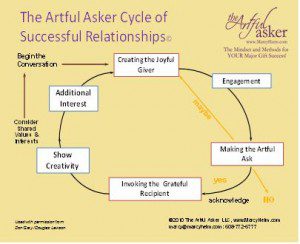Can You be Trusted?
Ah, love! From Valentine’s Day to the promise of renewal each March….there is nothing as wonderful as having special folks to share life with. We toss around the word, “love” pretty freely. “Give your donors love.” “Make your donors feel loved.” This is fine, but personally and professionally it comes with some responsibility.
At the core of every loving relationship is trust. Can YOU be trusted?
Trust Formula. Stephen M. R. Covey wrote The Speed of Trust. In it he outlines that High Trust yields High Speed and Lower Costs. Let’s apply this to major gift relationship building and my Cycle of Successful Relationships. Would you agree that when a major donor trusts us…as individual development professionals AND as an organization, they are more likely to give more and more often? YES!
Did you ever consider the HIGH COST of breaking donor trust? And…think about the extra energy we need to expend to REGAIN that trust! That’s an additional cost folks!
So What Builds Trust and What Breaks Trust with your Major Givers? True or False.
 It’s fine to talk about “prospects” “suspects” “moves management” “closing a donor” “finding what will get them to give the most” etc. back at the office. Of course you’d use other words when visiting with your donors directly.
It’s fine to talk about “prospects” “suspects” “moves management” “closing a donor” “finding what will get them to give the most” etc. back at the office. Of course you’d use other words when visiting with your donors directly.- You provide a receipt for a gift within 24 hours that has the correct amount, the correct fund or designation, and it reaffirms that the investment, regardless of size, was impactful and appreciated.
- At the end of a major donor visit, you say you will get back in touch early next week with the promised information and you call with it the next Tuesday afternoon.
- You create a RAP (Relationship Action Plan) for your major donors and execute an “artful touch” by you or a partner once each month.
- You arrange a visit with your major donor each fall to ask for/remind them of the payment on their major gift pledge or ask for event sponsorship.
- When a staff member is leaving the organization, regardless of terms, you encourage the departing staff member to share how to stay in touch with them with their donors if they so desire.
- When there’s a hiccup and a mistake is made in executing a gift, you move quickly to get it back on track, but no need to tell the donor if it can be handled “behind the scenes.”
- You remember your donor’s birthday, anniversary, dog’s name, favorite staff member, how they best like to hear from you (phone, email, text etc), what their fears are, what their dreams are, why giving to you brings them joy because you authentically care about them as a person, not just a source of money for your organization.
You see the pattern. The odd numbers damage trust, the even numbers build trust. Let me briefly share why.
- Who wants a friend, a spouse, a colleague, a boss, a team member, a fundraiser who talks about them differently behind their back then to their face? The words we use are important. Think about the major donor who is ask later to help encourage others to give. He/she discusses how they will ‘move’ Joe to the ask….. Have you ever considered how this makes your donor feel?
- Steward the gift. Quickly, accurately, sincerely. Doesn’t have to be fancy, handwritten, signed by BigWig – just done. Quickly, accurately, sincerely.
- CEO of Management Training Seminars, Dr Elaine Beaubien, stresses communication that leaves no ambiguity builds trust. To your donor, ‘early next week” could mean 8:00 am Monday morning and you are woefully late in responding. Be specific. Be clear. Check for clarity.
- Trust loves consistency. Nothing builds trust more than consistent, artful touches.
- “The only time I see you is when you want money.” Enough said.
- Feelings between people are to be left to them to manage in change. In divorce, leadership changes, turnover….people who wish to stay connected will. We don’t need to bless it or forbid it.
- Even small omissions have a way of surfacing. And them somehow they seem so ugly. Best to speak the truth at all times. Drama is not necessary.
- Our systems and databases help us honor our relationships; ensure continuity during change and over the years. You may think only you know your true feelings and motivations. I guarantee who you really are shows through.
When we take actions day to day from a place of authenticity that genuinely communicates gratitude for generosity and engages our donors in the life of our organization, trust increases and, yes, giving results are higher. It seems donors more quickly ask, “How can I be more involved?” “What’s next?” There was an elderly woman who invested in leadership training for students at a faith-based client of mine. We felt she would enjoy meeting a former recipient who later gave a gift himself to the program. When we ask her if we could bring this student along she said, “Oh good! Does he need money too?”
Invest in Joy!

